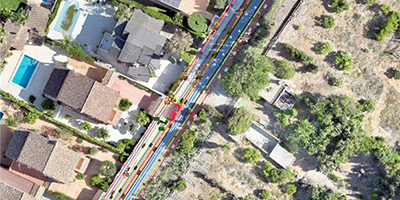01 October 2025
Solving the underground and mapping the invisible
How Elia Group is exploring advanced underground mapping to accelerate projects, reduce risk and improve safety.
Why this project
As urban environments grow denser and infrastructure projects become more complex, understanding what lies beneath the surface is more important than ever. Traditional underground documentation is often outdated or incomplete, forcing project teams to rely on test trenches and proceed with caution during excavation. This not only slows down timelines but also increases costs and increases safety (and project) risks.
Underground scanning technologies offer a promising alternative. By providing a clearer, more accurate picture of subsurface conditions, these solutions have the potential to significantly improve safety, reduce unexpected delays, and streamline project execution.
Mapping the future of underground infrastructure
A wide range of technologies already exist: from ground-penetrating radar to electromagnetic sensors, each with its own strengths and limitations. One solution caught our eye: Exodigo, a platform that promises to provide the most complete and precise underground maps in the industry. By fusing multiple scanning technologies and AI, they aim to generate highly accurate underground maps.
In a recent collaboration, the Innovation Team at Elia Group partnered with Elewit (Red Eléctrica) to put Exodigo’s capabilities to the test in a controlled environment. The goal? To evaluate whether this solution could help us build faster and safer, from the ground up.
How Exodigo works
Exodigo’s underground mapping process follows three phases:
- Preliminary analysis: Before any fieldwork begins, Exodigo reviews orthophotos, satellite imagery, existing utility records, and permitting data to build a contextual baseline.
- Field work: A multi-sensor approach is deployed, including GPR, electromagnetic sensors, high-precision GNSS, magnetic detectors, metal detectors, which subsequently allows for a fusion of these data sources to obtain a more accurate view. LiDAR scans are performed in accessible manholes and aerial photos are taken.
- Data fusion & mapping: All collected data is fused using AI to generate a single, high-resolution underground map, each source of data improves the accuracy, reliability and overall detection capabilities.
The final output is delivered as a georeferenced utility map compatible with GIS, AutoCAD, BIM, and other tools.
Results & Next Steps
During the on-site tests in Spain, Exodigo demonstrated strong performance, delivering accurate and mostly complete results with clear maps in all required formats. While some utilities were not detected and a few false positives were observed, the overall performance was comparable to other top-tier solutions currently available.
In general, these tests show that underground scanning technologies can certainly enhance our understanding of the underground. The ability to “fuse” different data sources shows promising improvements in accuracy and detection, although some limitations remain. This raises important questions about the role these technologies can play in infrastructure projects. Varying from targeted use in complex, data-scarce environments to potentially becoming a standard step in urban project planning.
Elia Group Innovation will continue to follow, explore and test these technologies as part of our efforts to further streamline our projects and continuously improve safety.
Partners
  |
 |
 |



